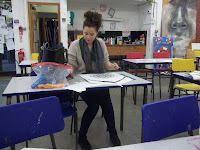I hope that my final outcome reflects my holiday and the experience I have strongly. Placing sand on the floor also aimed to do this combined with the bright light and the interesting shapes and words coming out of the suitcase. I think it does give viewers a sense of the summer that I had.
· The array of items I had to create to fill the window successfully and for it to look effective
· The detail and precison it took for the cut-outs to look effective
· Creating a wide variation of objects
· Making the objects look like they are popping out
· Hanging all the objects effectively in a good order
· Lighting the objects well to create interesting shadows
If I had the chance to re-make or improve my final outcome I would:
· Have more detail on the bigger cut-outs of card
· Have all the pieces of card covered in images and things I collected over the summer
· Have more middle sized pieces of card so that, there was more variation
· Experiment with different colours on the background, possibly black
· Make the objects look more like they are exploding out
Artist links:The idea of an intractive installation came when I was looking over the work of Punch Drunk. I have not taken it to such a full on level by compeletly submerging the viewer in the work, as they do- but I have tried to give a slight interaction with my work. My link to Peter Callesen is very strong as he used plain white sheets of paper to create something new using the paper cut technique. Creating works which ether coming out of the surface of the paper or become it. I found this very challanging in my work and now have a better understanding of the skill and precision it takes for him to create his amazing pieces. However unlike Callesen on some of my cut-outs I used coloured images of things I had collected or parts of my diary when I was on holiday as I thought this reflected my summer better. I also tried to use light in a strong and effective way like Cornelia Parker does combined with her idea of objects looking like they were exploding. I tried to create the affect so that it looks like my summer holiday was exploding out of my suitcase.
Through creating this piece I have developed a number of skills. I think the skill I have most imporoved on is my attention to detail, as this outcome has lots of small details which made it succesful. This outcome also helped me to have a deep understanding of different artists work and the specific features of their style. Which I may not have used when working on other pieces of work. This project also allowed me to explore space and the idea of layers which I found very intresting. I certainly would hope to be able to explore is area futher. I chose to layer the butterflies on the outer side of the window right at the very end. This addition to my piece allows the viewer to be able to interact with the piece by taking some of the butterflies off to reveal more of what is behind. It also allows a final layer on the work, therefore the inside of the window looks different due to the filltered butterfiles.
 Over all I think My final outcome was quite succesful as I completly filled the space as well as I could and created a dynamic composition. I used paper as my main material and it was sucessful as it was easy to form into the shapes I wanted. It may have been better if it was more sturdy and strong, so that it holds its shape better though. I used light to help support my work to make it look more exciting. Finally I think I strongly refelcted the expirence of my summer and how it made me feel. I would hope that the viewer could take an understanding my expirence and that it somehow triggers a memory of their own
Over all I think My final outcome was quite succesful as I completly filled the space as well as I could and created a dynamic composition. I used paper as my main material and it was sucessful as it was easy to form into the shapes I wanted. It may have been better if it was more sturdy and strong, so that it holds its shape better though. I used light to help support my work to make it look more exciting. Finally I think I strongly refelcted the expirence of my summer and how it made me feel. I would hope that the viewer could take an understanding my expirence and that it somehow triggers a memory of their own

































